实验3:OpenFlow协议分析实践
(一)基本要求
- 搭建下图所示拓扑,完成相关 IP 配置,并实现主机与主机之间的 IP 通信。用抓包软件获取控制器与交换机之间的通信数据包。

| 主机 | IP地址 |
|---|---|
| h1 | 192.168.0.101/24 |
| h2 | 192.168.0.102/24 |
| h3 | 192.168.0.103/24 |
| h4 | 192.168.0.104/24 |


查看抓包结果,分析OpenFlow协议中交换机与控制器的消息交互过程,画出相关交互图或流程图。
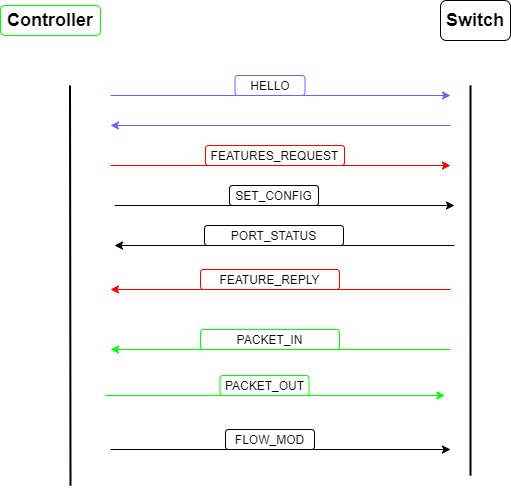
HELLO
控制器与交换机建立连接
源端口6633 -> 目的端口51732,从控制器到交换机,协议为openflow1.0
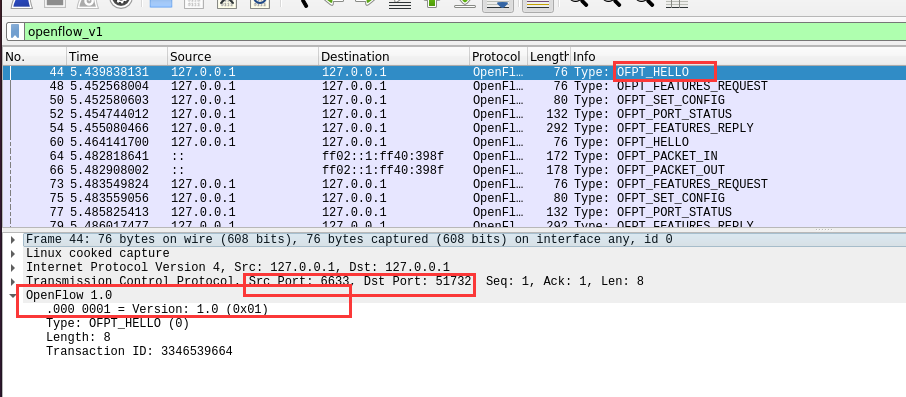
源端口51732 -> 目的端口6633,从交换机到控制器,协议为openflow1.5

FEATURES_REQUEST/FEATURES_REPLY
- FEATURES_REQUEST
控制器请求交换器的特征信息
源端口6633 -> 目的端口21732,从控制器到交换机
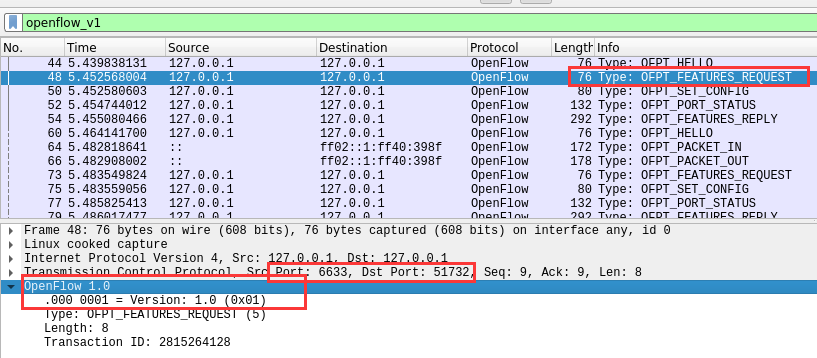
-
FEATURES_REPLY
源端口51732 -> 目的端口6633,从交换机到控制器
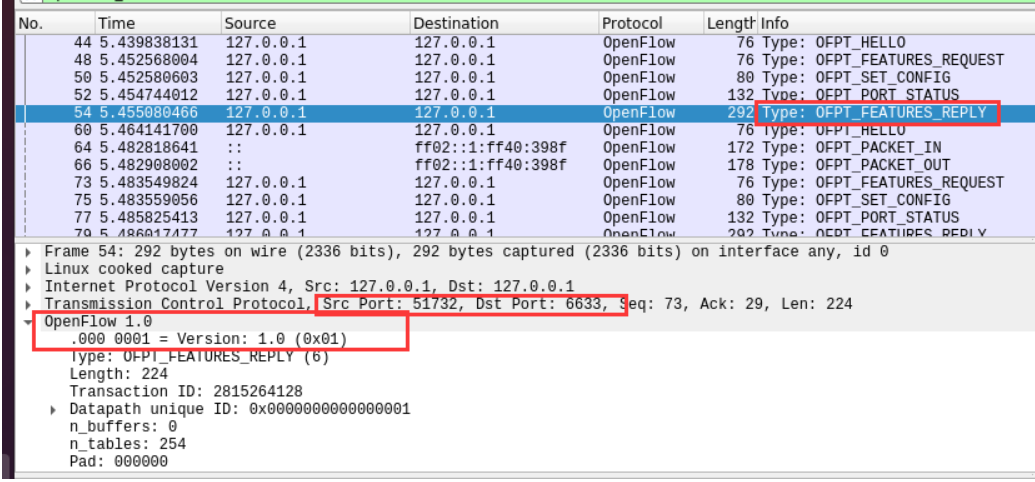
交换机通知控制器它的特征信息
SET_CONFIG
源端口6633 -> 目的端口51732,从控制器到交换机
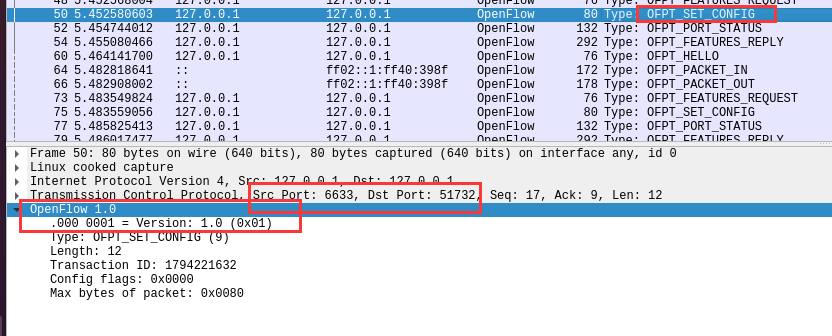
控制器要求交换机按照所给出的信息进行配置
PORT_STATUS
源端口51732 -> 目的端口6633,从交换机到控制器

当交换机端口发生变化时,交换机告知控制器相应的端口状态
PACKET_IN
源端口51734 -> 目的端口6633,从交换机到控制器
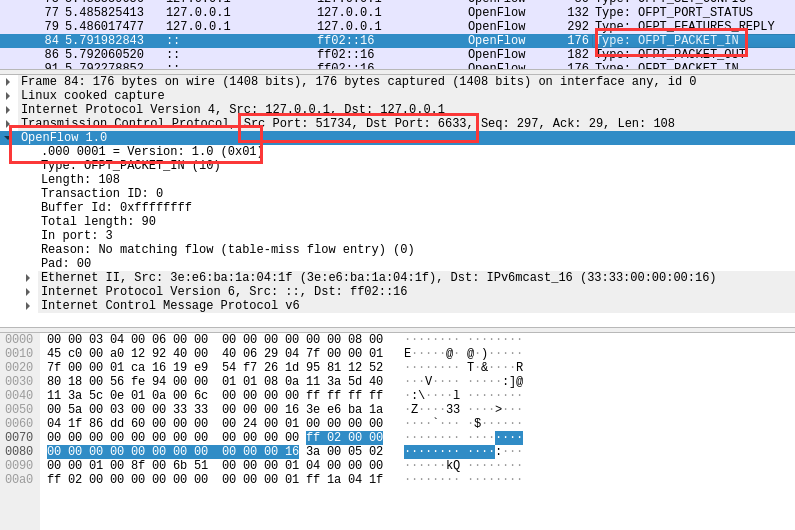
交换机告知控制器有数据包进来,请求控制器指示
PACKET_OUT
PACKET_OUT是从控制器向交换机发送的消息,源端口6633-> 目的端口51732,包含数据包发送命令的消息
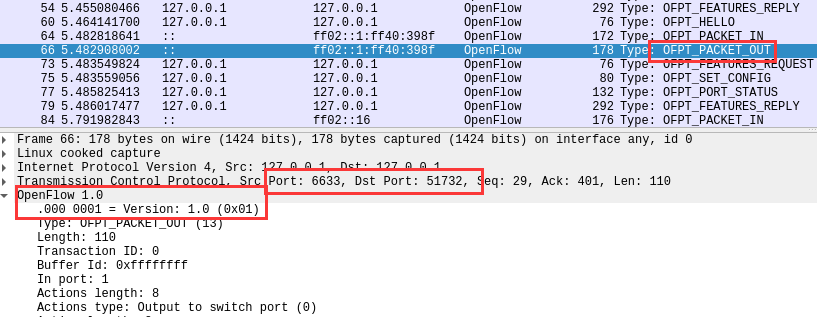
控制器要求交换机按照所给出的action进行处理
- 回答问题:交换机与控制器建立通信时是使用TCP协议还是UDP协议?
由截图可以看出,交换机与控制器建立通信时是使用TCP协议
(二)进阶要求
-
将抓包结果对照OpenFlow源码,了解OpenFlow主要消息类型对应的数据结构定义。
HELLO
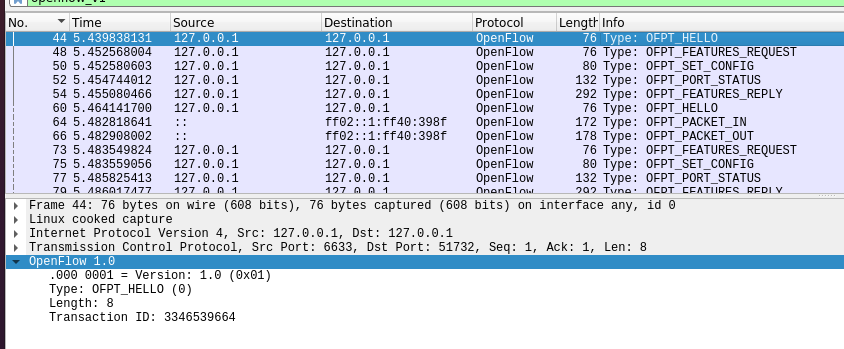
struct ofp_header { uint8_t version; /* OFP_VERSION. */ uint8_t type; /* One of the OFPT_ constants. */ uint16_t length; /* Length including this ofp_header. */ uint32_t xid; /* Transaction id associated with this packet. Replies use the same id as was in the request to facilitate pairing. */ }; struct ofp_hello { struct ofp_header header; };可以看到,代码中ofp_header的变量和图片中的显示一一对应,分别由version,type,length和ID
FEATURES_REQUEST

可以看到格式与上述ofp_header结构体中数据相同
FEATURES_REPLY

struct ofp_switch_features { struct ofp_header header; uint64_t datapath_id; /* Datapath unique ID. The lower 48-bits are for a MAC address, while the upper 16-bits are implementer-defined. */ uint32_t n_buffers; /* Max packets buffered at once. */ uint8_t n_tables; /* Number of tables supported by datapath. */ uint8_t pad[3]; /* Align to 64-bits. */ /* Features. */ uint32_t capabilities; /* Bitmap of support "ofp_capabilities". */ uint32_t actions; /* Bitmap of supported "ofp_action_type"s. */ /* Port info.*/ struct ofp_phy_port ports[0]; /* Port definitions. The number of ports is inferred from the length field in the header. */ }; /* Description of a physical port */ struct ofp_phy_port { uint16_t port_no; uint8_t hw_addr[OFP_ETH_ALEN]; char name[OFP_MAX_PORT_NAME_LEN]; /* Null-terminated */ uint32_t config; /* Bitmap of OFPPC_* flags. */ uint32_t state; /* Bitmap of OFPPS_* flags. */ /* Bitmaps of OFPPF_* that describe features. All bits zeroed if * unsupported or unavailable. */ uint32_t curr; /* Current features. */ uint32_t advertised; /* Features being advertised by the port. */ uint32_t supported; /* Features supported by the port. */ uint32_t peer; /* Features advertised by peer. */ };SET_CONFIG
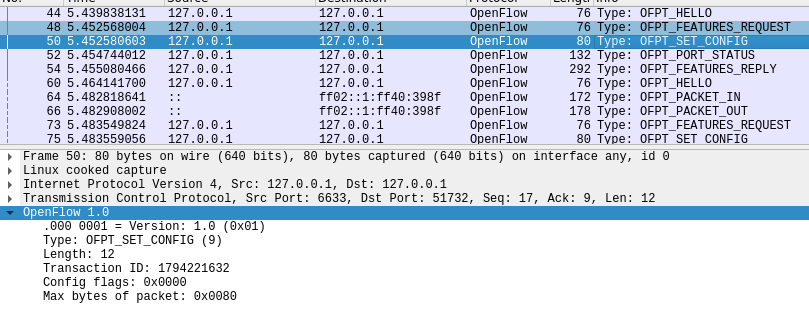
/* Switch configuration. */
struct ofp_switch_config {
struct ofp_header header;
uint16_t flags; /* OFPC_* flags. */
uint16_t miss_send_len; /* Max bytes of new flow that datapath should
send to the controller. */
};
可以看到源码与图中信息一一对应,其中包含ofp_header结构体
PORT_STATUS

/* A physical port has changed in the datapath */
struct ofp_port_status {
struct ofp_header header;
uint8_t reason; /* One of OFPPR_*. */
uint8_t pad[7]; /* Align to 64-bits. */
struct ofp_phy_port desc;
};
PACKET_IN

enum ofp_packet_in_reason {
OFPR_NO_MATCH, /* No matching flow. */
OFPR_ACTION /* Action explicitly output to controller. */
};
struct ofp_packet_in {
struct ofp_header header;
uint32_t buffer_id; /* ID assigned by datapath. */
uint16_t total_len; /* Full length of frame. */
uint16_t in_port; /* Port on which frame was received. */
uint8_t reason; /* Reason packet is being sent (one of OFPR_*) */
uint8_t pad;
uint8_t data[0]; /* Ethernet frame, halfway through 32-bit word,
so the IP header is 32-bit aligned. The
amount of data is inferred from the length
field in the header. Because of padding,
offsetof(struct ofp_packet_in, data) ==
sizeof(struct ofp_packet_in) - 2. */
};
前面提到packetin分两种情况,所以有两段代码,抓到的是第二种,固定收到向控制器发送包
packet_out
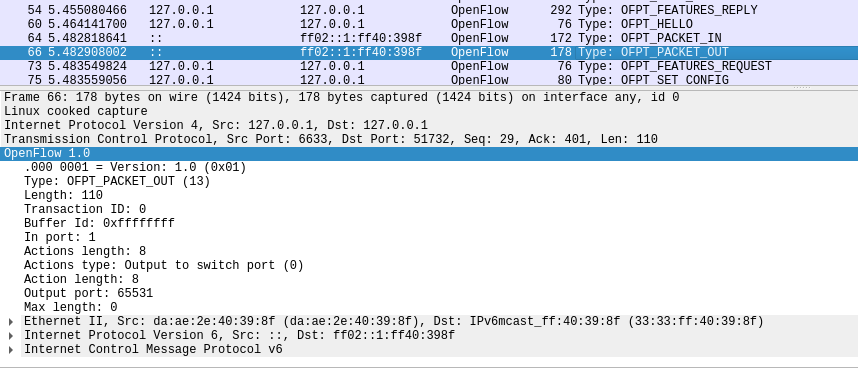
struct ofp_packet_out {
struct ofp_header header;
uint32_t buffer_id; /* ID assigned by datapath (-1 if none). */
uint16_t in_port; /* Packet's input port (OFPP_NONE if none). */
uint16_t actions_len; /* Size of action array in bytes. */
struct ofp_action_header actions[0]; /* Actions. */
/* uint8_t data[0]; */ /* Packet data. The length is inferred
from the length field in the header.
(Only meaningful if buffer_id == -1.) */
};
FLOW_MOD

struct ofp_flow_mod {
struct ofp_header header;
struct ofp_match match; /* Fields to match */
uint64_t cookie; /* Opaque controller-issued identifier. */
/* Flow actions. */
uint16_t command; /* One of OFPFC_*. */
uint16_t idle_timeout; /* Idle time before discarding (seconds). */
uint16_t hard_timeout; /* Max time before discarding (seconds). */
uint16_t priority; /* Priority level of flow entry. */
uint32_t buffer_id; /* Buffered packet to apply to (or -1).
Not meaningful for OFPFC_DELETE*. */
uint16_t out_port; /* For OFPFC_DELETE* commands, require
matching entries to include this as an
output port. A value of OFPP_NONE
indicates no restriction. */
uint16_t flags; /* One of OFPFF_*. */
struct ofp_action_header actions[0]; /* The action length is inferred
from the length field in the
header. */
};
struct ofp_action_header {
uint16_t type; /* One of OFPAT_*. */
uint16_t len; /* Length of action, including this
header. This is the length of action,
including any padding to make it
64-bit aligned. */
uint8_t pad[4];
};
总结
这次作业比较直接,但增加了对OpenFlow在交换机和控制器间的交互过程的学习,第一次去看源代码,但好像没起到什么作用。看源代码时主要就是看其中定义的结构体,结构体中的信息和报文信息进行匹配,来一一对应。这次作业遇到的问题有一个,就是我没有抓到FLOW_MOD包,原因不清楚,但除了这个其他步骤都没有出问题,还有一个是PACKET_IN报文中的两种触发形式只有捕获到一种,但这个应该是正常的,因为和其他同学交流,大家也没有捕获到这个报文。希望今后可以更多学习到可编程的知识。